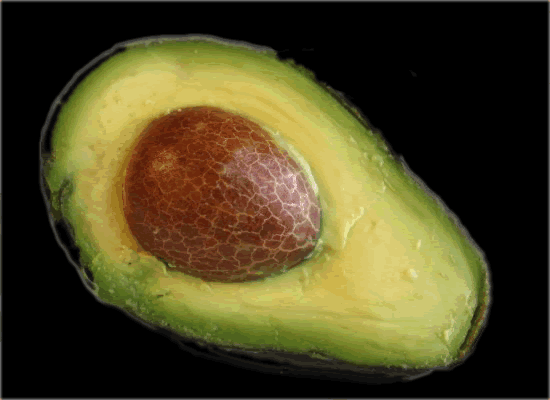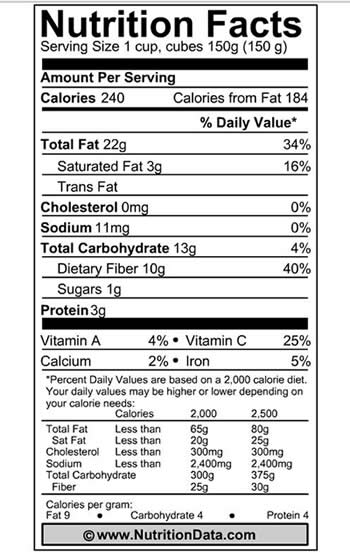So much has come out lately in health news circles about the wonders and benefits of avocados. The avocado is touted as a superfood, effective for conditions and ailments ranging from osteoarthritis to cardiovascular disease, from dry skin to depression. As more studies come out about its properties and qualities, we can see that, indeed, we might all do well to incorporate the avocado into our regular diets,
The avocado tree is native to Central and South America. Its common English name comes from the Nahuatl (Aztec) language, ahuacatl, although in South America is known as palta. It is also known in the United States as the Alligator Pear, perhaps because of the thick, sometimes bumpy, alligator-like skin of some of the varieties.

Avocados are cultivated widely in California and Florida in the United States, as well as in other mild and sub-tropical climes around the globe; however, the hills of Uruapan, Michoacan, Mexico constitute one of the most productive avocado-growing regions of the world: That’s lucky for us here in Zihuatanejo, where we’re only a two-and-a-half-hour drive from that fertile area; we have avocados almost year-round, and most of the time at reasonable cost. The local markets and supermarkets often carry the smaller, thin-skinned, native or criollo varieties, even though the principal commercial variety is the buttery, smooth Haas. The Haas is favored by avocado producers because of the fine texture and flavor of its flesh, its high oil content, and its thick skin that allows it to easily be transported long distances without great spoilage.
Avocados have been highly regarded in Mexican herbal folklore. Traditional uses include taking a tea of the skin, seed, and/or leaves first thing in the morning, prior to any other food or drink and for three to four days in a row, as an antihelminthic or an antiparasitic (expeller of worms and other parasites). The oily avocado pulp and sometimes the fresh leaves are used to treat sores and wounds. Both are said to be effective for dry skin conditions and skin blemishes. For hair loss, folk medicine recommends grinding or pounding the leaves or seeds with water and working the paste into the hair and scalp.
(http://www.medicinatradicionalmexicana.unam.mx/monografia.php?l=3&t=&id=7088)
Try this killer, vegan Frozen Choco-Mint Pudding made with avocados
In a recent article (http://omtimes.com/2012/10/13-great-benefits-of-eating-avocado-seeds/), Dr Paul Haider talks about the quality and concentration of beneficial substances in the avocado seed and avocado seed oil, not just the flesh, citing studies that show that avocado seeds contain high concentrations of antioxidants that are beneficial for the gastrointestinal tract and immune system, soluble fiber that can help prevent cardiovascular disease, and a flavonol that shows promise as an inhibitor of tumor growth.
One method the article suggests for using dried avocado seeds is to place them in a bag and crush or pound them with a hammer, and then grind them, a little at a time, into a powder in a super-strength blender or grinder. The powder can then be added to smoothies, soups, and baked goods.
The thought of using the seeds makes me happy: those seeds don’t break down well in the compost heap, but I always feel guilty throwing them into the regular trash.
 According to NutritionData.com, avocados contain significant levels of protein, vitamin C, vitamin K, vitamin E, folic acid, dietary fiber, potassium, and, of course, those healthy fats.
According to NutritionData.com, avocados contain significant levels of protein, vitamin C, vitamin K, vitamin E, folic acid, dietary fiber, potassium, and, of course, those healthy fats.
The Pubmed website lists a number of studies on the health benefits of avocado. Here’s some further reading for those interested:
Avocados and Cancer Prevention: a study in which avocados were found to contain several bioactive substances such as the carotenoids lutein, zeaxanthin, alpha-carotene, and beta-carotene, as well as vitamin E and monounsaturated fat, which together have been shown to inhibit the growth of certain cancer cell.
http://www.ncbi.nlm.nih.gov/pubmed/15629237
Avocado and Blood Cholesterol levels: A study that suggests that an avocado-rich diet can improve the lipid profile of certain patients.
http://www.ncbi.nlm.nih.gov/pubmed/8987188
The Avocado and Antioxidant and Antimicrobial Activity: This study reports on phenolic compounds present in extract of avocado peel, pulp, and seed that show antioxidant and antibacterial activity.
http://www.ncbi.nlm.nih.gov/pubmed/21480593
The Composition and Health Benefits of the Hass Avocado:
http://www.ncbi.nlm.nih.gov/pubmed/23638933
For general information about the avocado and all its benefits, visit: http://www.medicalhealthguide.com/healthbenefits/avocado.htm
And for those who like to delve into the background and history of what we consume, here’s an interesting historical tidbit on the avocado in trade and commerce
After the North American Free Trade Agreement (NAFTA) went into effect in 1994, Mexico tried exporting avocados to the US. The US government resisted, claiming the trade would introduce Tephritidae fruit flies that would destroy California’s crops. The Mexican government responded by inviting USDA inspectors to Mexico, but the U.S. government declined, claiming fruit fly inspection was not feasible. The Mexican government then proposed to sell avocados only to the northeastern US in the winter (fruit flies cannot withstand extreme cold). The US government balked, but gave in when the Mexican government started erecting barriers to US corn.
Another argument is that the lower prices generated by Mexican (and Chilean) imports would increase the popularity of avocados outside of California, thereby assuaging the loss of profits due to the new competition.
Today, avocados from Mexico are allowed in all 50 states, because USDA inspectors in Michoacán (where 90% of Hass avocados from Mexico are grown) inspected fruit in Uruapan. Imports from Mexico in the 2005–2006 season exceeded 130,000 tonnes.
In 2009, Peru joined Chile and Mexico as an exporter of avocados to the US.
In the US avocados are grown in California and Florida, where land, labor and water are expensive. Avocado trees require frequent, deep watering to bear optimally, particularly in spring, summer, and fall. Due to increased Southern Californian water costs, they are now costly to grow. California produces 90% of the United States’ avocados.
As of 2013, Mexico leads international exports, with other significant production in California, New Zealand, Peru and South Africa.